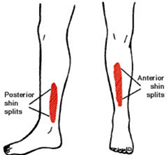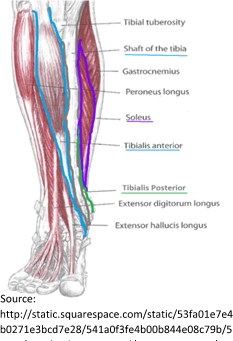Medial Tibial Stress Syndrome (MTSS) is also known as ‘shin splints’. MTSS is felt as a vague pain at the front of your legs by your shins and does not just affect one small spot.

Source: https://doctorsorthotics.com/wp-content/uploads/2016/05/shin_splints.jpg
In the past, it was believed to be a bone injury, hence ‘shin splints’. However, recent studies show that it involves either the muscles around the tibia (shin bone) or  the tibia itself or the bone sheath (periosteum) or a combination. MTSS is due to multiple micro-tears or micro-fractures from overuse. A micro-tear or micro fracture is a teeny tiny injury on its own, but in MTSS there are several of them along the implicated structure (bone and/or muscle) and so causing pain.
the tibia itself or the bone sheath (periosteum) or a combination. MTSS is due to multiple micro-tears or micro-fractures from overuse. A micro-tear or micro fracture is a teeny tiny injury on its own, but in MTSS there are several of them along the implicated structure (bone and/or muscle) and so causing pain.
A micro tear or micro fracture is very small and so will heal well when the force or overuse that caused it is removed. However, if the cause is not managed and the overuse continues it may result in a stress fracture of the bone. Thus, MTSS is treated by determining and managing the cause.
MTSS is usually a result of poor conditioning such as when taking up a new sport or doing more of an existing sport. It is usually from doing too much too soon. However, MTSS can also be due to overuse from poor foot function or worn out shoes.
MTSS may be painful during activity but is worse the next morning as the soft tissue tightens overnight while resting. It is also painful to bend your ankle upwards as far as you can.
Treatment from home:
- It is very important that you have a week or two at least of complete rest. After this, you can gradually reintroduce activity if your symptoms have resolved. Start slow and simple and gradually increasing your level of activity. If your symptoms flare up again, back off on the exercise.
- Ice the area with ice wrapped in a tea towel to help manage the pain.
- Diligently complete any exercises or stretches advised by your podiatrist.
- Wear your good joggers as much as possible.
- If your MTSS progresses to a stress fracture, you will require a ‘moon boot’, so do your best to follow any advice given to you by your podiatrist.
Treatment from the podiatrist may include:
- Orthotics to improve your foot posture and function. This means your muscles won’t have to work as hard and so won’t get over worked as quickly so reducing your pain and preventing recurrence.
- Taping to temporarily mimic an orthotic as best as possible until your orthotics are ready.
- Footwear advice.
- Return to sport schedule advice.
- Recommending appropriate exercises and stretches.
- Dry needling or massage to help relax tight or overworked muscles.
- Referral for imaging or pressure testing if symptoms persist to rule out other possible causes of the pain.

Comments are closed.